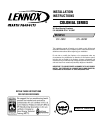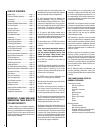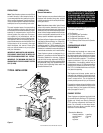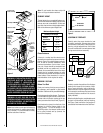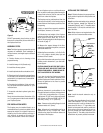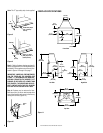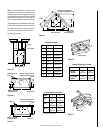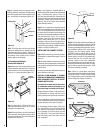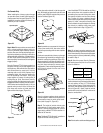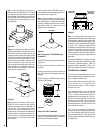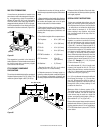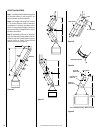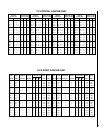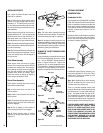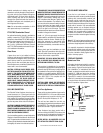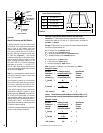
NOTE: DIAGRAMS & ILLUSTRATIONS NOT TO SCALE.
9
Step 4.
Note:
Chimney sections are constructed
with a unique locking tab design, which en-
sures an immediate, tight assembly between
sections. Plan your chimney requirements care-
fully before assembly as chimney is difficult to
disassemble after installation. If disassembled,
the tabs might become damaged. Be certain
tabs are properly formed to ensure locking tabs
engage properly.
Security Chimneys FTF10 chimney system is a
two piece chimney, which snap together from
the fireplace up. Start with the inner flue section
with the lanced end up, snap lock it in to the
matching collar on top of the fireplace. At all
subsequent joints, the upper flue section fits
into the preceding flue section. Each piece
snaps together by means of locking tabs (9
locking tabs per joint). Check each piece by
pulling up slightly from the top to ensure proper
engagement before installing the next section.
If the flue has been installed correctly, it will not
separate when you test it. Also, the inner flue
joint where each section is joined should be
tight and flat without gaps (
Figure 24
).
FTF8-S4 Stabilizer
Figure 24
Locking
Tabs
(Lances)
Figure 25
Install the Model FTF10-S4 stabilizer by fitting
inner section down into respective section of
proceeding flue pipe and locking outer stabi-
lizer section into place over the outer chimney
pipe. Position for proper clearance through
framed opening and nail straps securely (under
tension in “shear”) into place on framing. Use
8d nails. Attach successive lengths of chimney
pipe directly to stabilizer using same tech-
niques as described in Step 4 (
Figure 27
).
Figure 27
Note: Assemble one component of chimney at
a time (inner section first, then outer section
last) before proceeding with the next complete
section.
Continue to assemble the chimney up through
framed opening. Assemble just enough to pen-
etrate the roof flashing openings (
Figure 26
).
Always maintain 2" minimum air space to com-
bustible materials and always check each chim-
ney joint (inner and outer) to ensure proper
engagement. Check vertical alignment of chim-
ney so that it projects from the roof in true
vertical position.
Outer pipe section installs in just the opposite
way; the lanced end goes down and each new
section goes OVER the outside of the previous
section installed (
Figure 25
).
For Canada Only
When installing the chimney system through
an open attic space, the attic shield assembly-
firestop spacer must be used (
Figure 23
). This
installation procedure is Warnock Hersey Inc.
listed only for use in Canada.
Figure 23
Open Attic Space
Figure 26
Security's chimney sections do not need to be
screwed together. Additional reinforcement is
not necessary except in certain offset condi-
tions (refer to page 12,
Figure 38
).
Step 5. The height of vertical chimney pipe
supported only by the fireplace must not ex-
ceed 30'. Chimney heights above 30' must be
supported by a Model FTF10-S4 stabilizer in-
stalled at 30' intervals.
Note: The Model FTF10-S4 adds 3" net effective
height to the total chimney system.
2" (51mm) Min. Air Space
to Combustibles
Note: Do not apply excessive pressure to any
subsequent chimney sections following the sta-
bilizer when installing. Ensure each subsequent
chimney section is securely attached by testing
as noted in Step 4.
Step 6. Select the proper Security Chimneys
roof flashing based on pitch of roof. Use chart
below for selection:
Roof Pitch Model
Flat to 6/12 F10F6
6/12 to 12/12 F10F12
Next, slide roof flashing over extended chimney
section that previously has been installed above
the roof opening in Step 4. FTF10 flashings
require flashing spacers. Slide flashing all the
way down until the flashing base rests flat on
the roof (
Figure 28
). Again, check the vertical
position of the chimney and the 2" minimum air
space to combustibles.
Figure 28
Note: Do not caulk or seal the ventilating openings.
FTF10 Chimney
FTF10 Flashing
Flashing Spacers
Do Not Seal



